Transportation Models
SCAG develops and maintains state-of-the-art transportation models to support SCAG’s planning program. These models include:
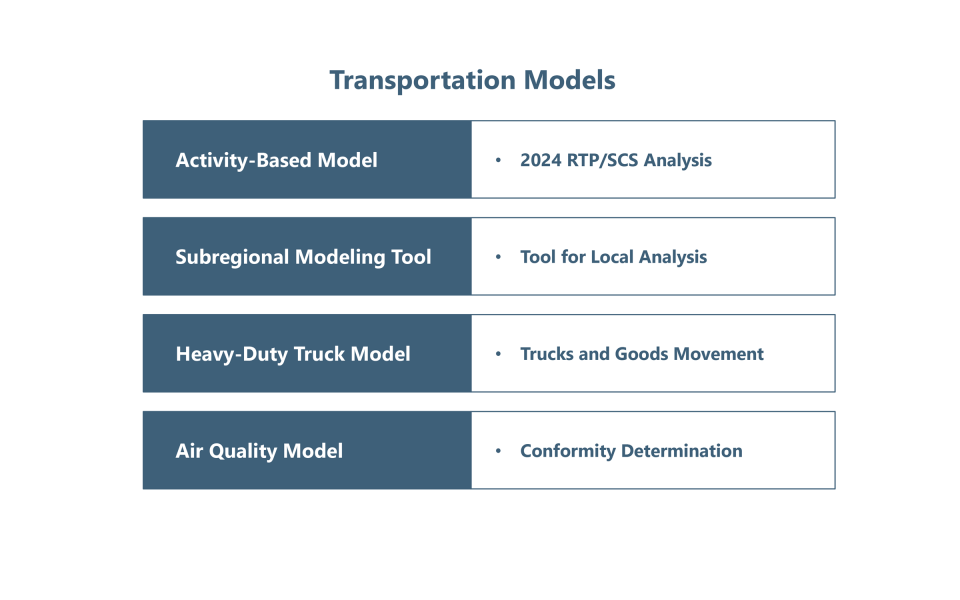
SCAG applies these models to forecast transportation conditions and resulting air quality.
Activity-Based Model
SCAG is the primary agency responsible for the development and maintenance of travel demand forecasting models for the SCAG region. SCAG has been developing and improving these travel demand forecasting models since 1967. SCAG applies the models to provide state of the practice quantitative analysis for the Connect SoCal Regional Transportation Plan/Sustainable Communities Strategy (RTP/SCS), the Federal Transportation Improvement Program, and air quality management plans. The regional model is also used to evaluate other transportation proposals within the region. The model is based on Caliper Corporation’s TransCAD modeling software and the latest generation of the Coordinated Travel – Regional Activity Modeling Platform.
The SCAG travel demand process is composed of two main components:
- The SCAG Activity-Based Model (ABM), which simulates daily activity participation and scheduling for individuals, with travel viewed as a derivative of out-of-home activity participation and scheduling decisions.
- A network assignment loads vehicles onto appropriate facilities to produce traffic volumes, congested speeds, vehicle-miles traveled, and vehicle-hours traveled estimates for each of the five time periods. The SCAG travel demand modeling process is shown in Figure 1. A series of multi-class highway assignments simultaneously load the vehicle forecasted by the SCAG ABM, pre-calculated trip origin and destination input matrices (airport, seaport, inter-regional by passenger vehicles), and three classes of heavy-duty trucks from the Heavy Duty Truck model.
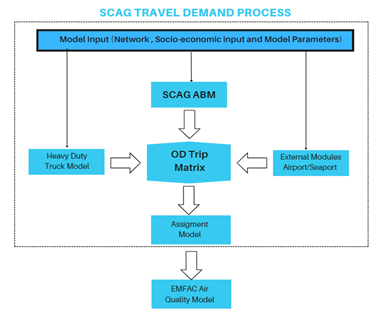
- Activity-Based Model Resources
Subregional Modeling Program
SCAG’s Subregional Modeling Program is a cornerstone initiative designed to enhance the capabilities of SCAG-member agencies, transportation commissions, subregions, and Caltrans by providing sophisticated modeling data and technical support.
The program promotes consistency among the various modeling agencies within the region, ensuring a unified, standard approach to transportation planning. By fostering a standard modeling framework, the program enhances the reliability, accuracy, and comparability of regional data, which is crucial for effective planning and policymaking. Consistency facilitates better coordination among agencies but and supports a more cohesive vision for the region’s development.
SCAG’s Subregional Modeling Program also significantly reduces the cost and effort involved in creating or upgrading subregional models. The program assists agencies in overcoming common challenges associated with model development and maintenance by providing shared resources, technical expertise, and advanced modeling tools. This collaborative approach not only optimizes resource utilization but also accelerates the implementation of innovative solutions tailored to the region’s unique needs.
By supporting informed decision-making and fostering a collaborative planning environment, the Subregional Modeling Program is vital in shaping a sustainable and resilient future for Southern California. Through this initiative, SCAG and its partners are better equipped to address the complexities of regional growth, transportation demands, and environmental sustainability, ultimately enhancing the quality of life for all residents in the region.
Heavy-Duty Truck Model

SCAG developed the Heavy-Duty Truck Model to evaluate important policy choices and investment decisions. The Heavy-Duty Truck Model is a primary analysis tool to support the goods movement policy decisions made by SCAG and regional stakeholders.
As part of the Connect SoCal 2024 Regional Transportation Plan/Sustainable Communities Strategy, the Heavy-Duty Truck Model focused on analytical needs to support project and policy planning.
The model development process included a thorough review of the Heavy-Duty Truck Model by an expert panel that ranged from academics to consultants. The Heavy-Duty Truck Model was validated by comparing the overall vehicle miles traveled for individual counties and air basins against the data obtained from the Highway Performance Monitoring System and screenline count.
The model documentation includes further information on the following topics:
- Heavy-Duty Truck Model Structure: The model forecasts trips for three heavy-duty truck (HDT) weight classes: light-heavy (8,500 to 14,000 lbs. gross vehicle weight (GVW); medium-heavy (14,001 to 33,000 lbs. GVW); and heavy-heavy (>33,000 lbs. GVW).
- Internal Heavy-Duty Truck Model: This includes all HDT trips that have both origins and destinations within the six-county modeling area.
- Ports HDT Trips: This includes truck trips coming out of and going into the airports and seaports in the region.
- External Heavy-Duty Truck Model: This includes the external HDT trips coming into, going out of, and passing through the region.
- Heavy-Duty Truck Model Calibration and Validation: This includes validation data, procedures, and results from various performance measures.
- Other components include time-of-day factoring, multi-truck classification assignment, and HDT composite operating cost.
- Heavy-Duty Truck Model Resources
- Heavy-Duty Truck Model Documentation
- SCAG’s Goods Movement Program works to optimize the region’s transportation system through increases in economic efficiency, congestion mitigation, safety and air quality improvements, and enhancements to system security. In doing so, SCAG evaluates all modes of freight, ultimately recommending a series of new policies for infrastructure improvements.
Air Quality Modeling & Analysis
SCAG is responsible for the Transportation Air Quality Conformity Determination for the Connect SoCal 2024 Regional Transportation Plan/Sustainable Communities Strategy and the Federal Transportation Improvement Program. These conformity responsibilities now include the new air quality standards for fine particulate matter (PM2.5) and 8-hour Ozone.
California’s adoption of Senate Bill (SB) 375, the Sustainable Communities and Climate Protection Act of 2008, assigns SCAG planning and modeling responsibilities. SB 375 implements the state’s greenhouse gas emissions (GHG) reduction goals in the sector of cars and light trucks. This mandate requires SCAG to meet its per-capita GHG emissions reduction targets at two points in the future: 2020 and 2035.
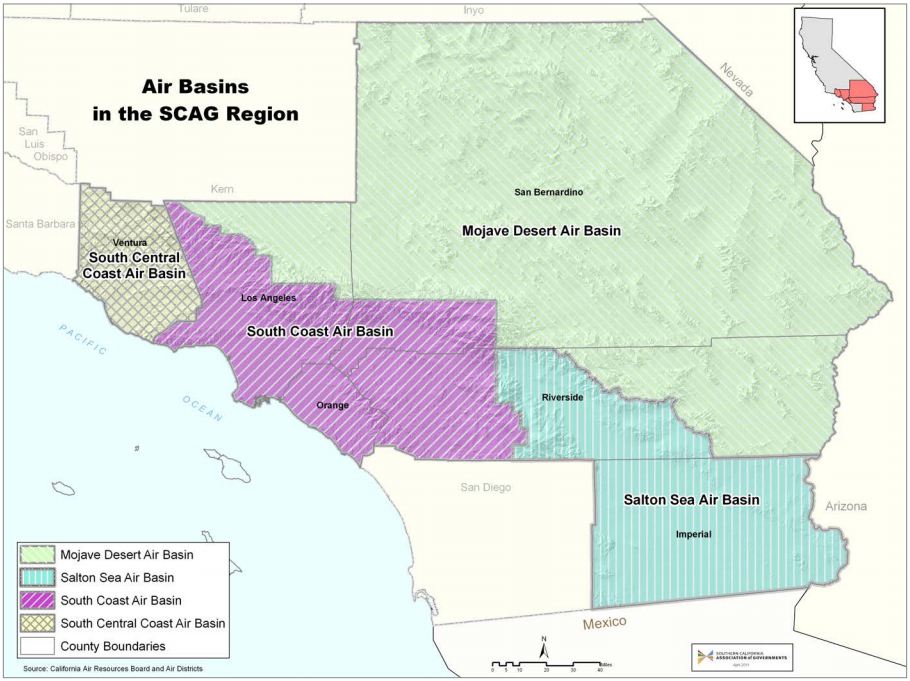
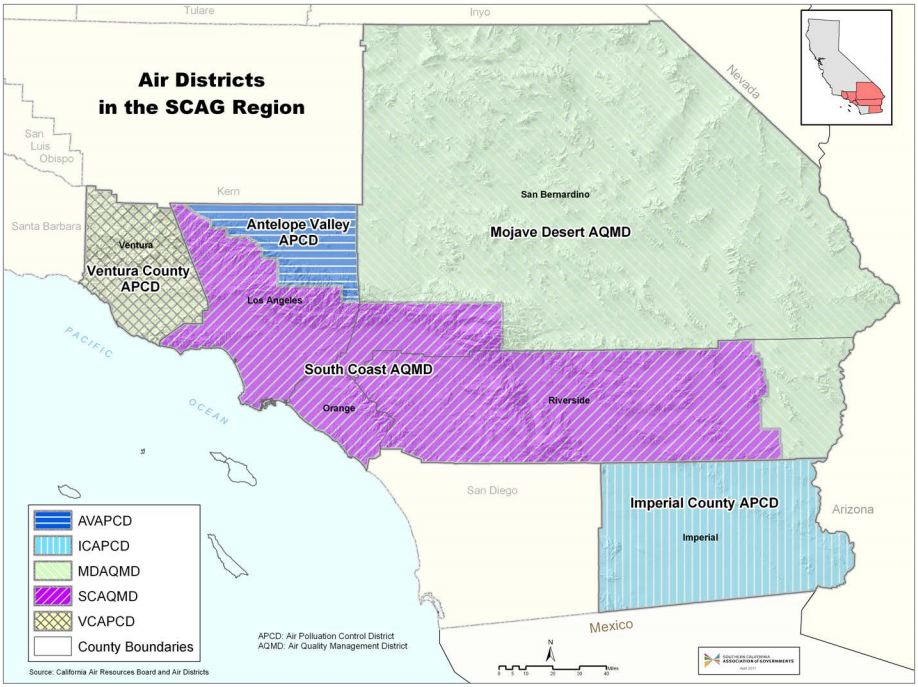
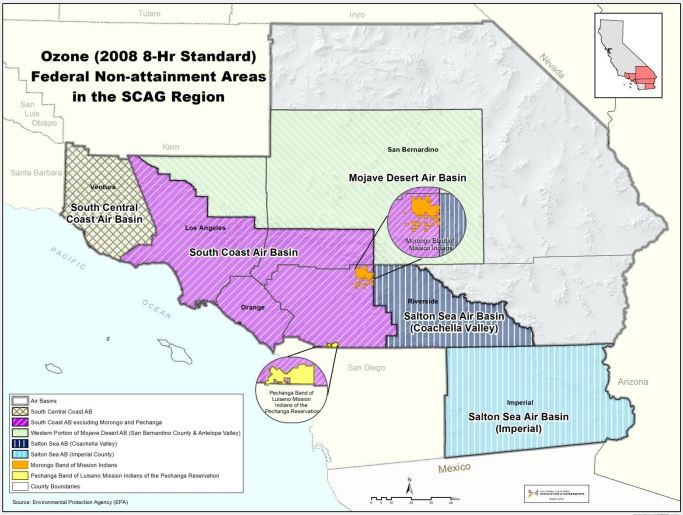
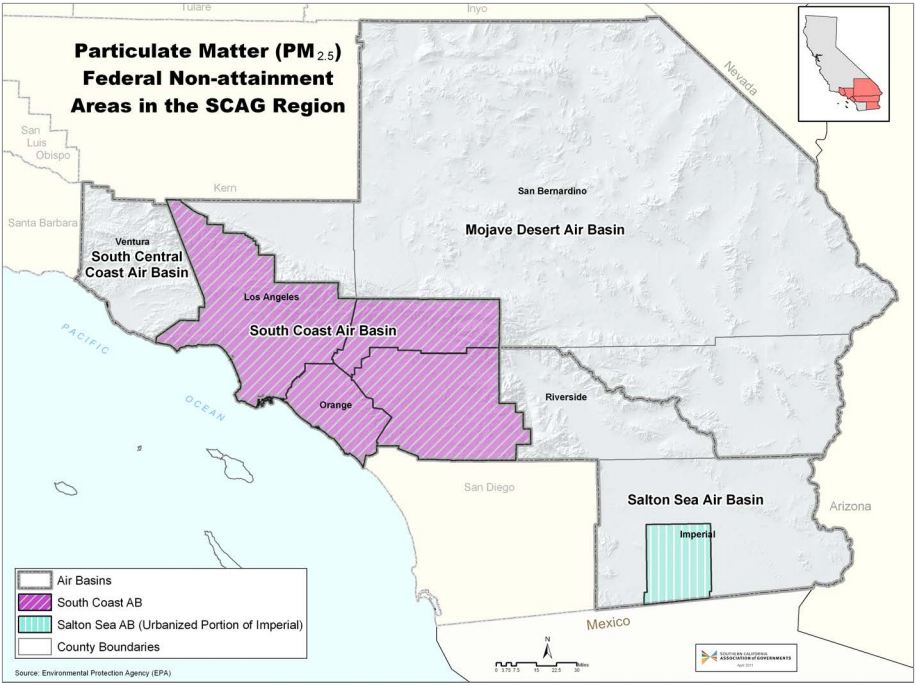
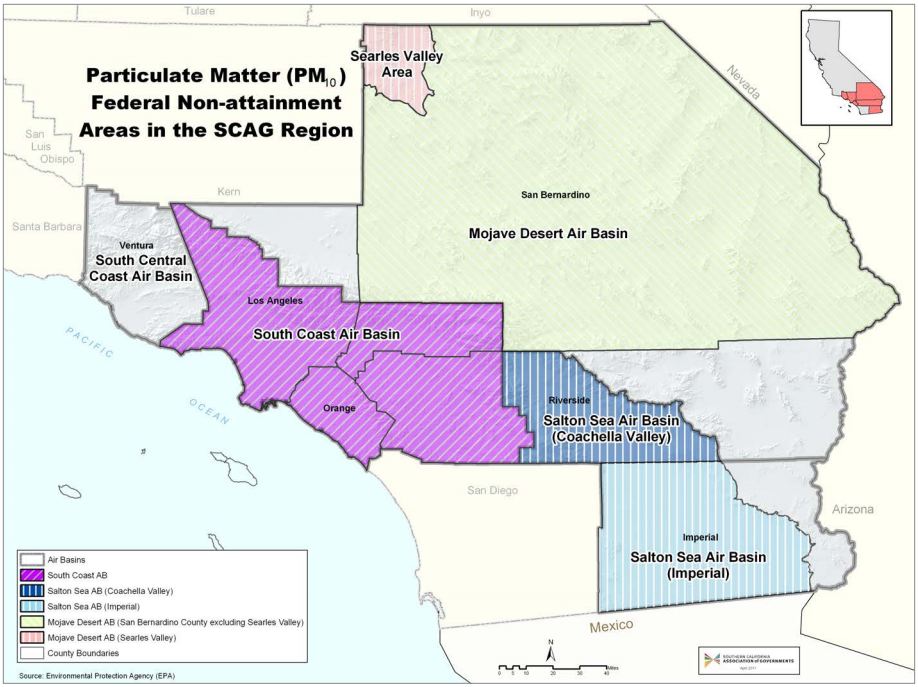
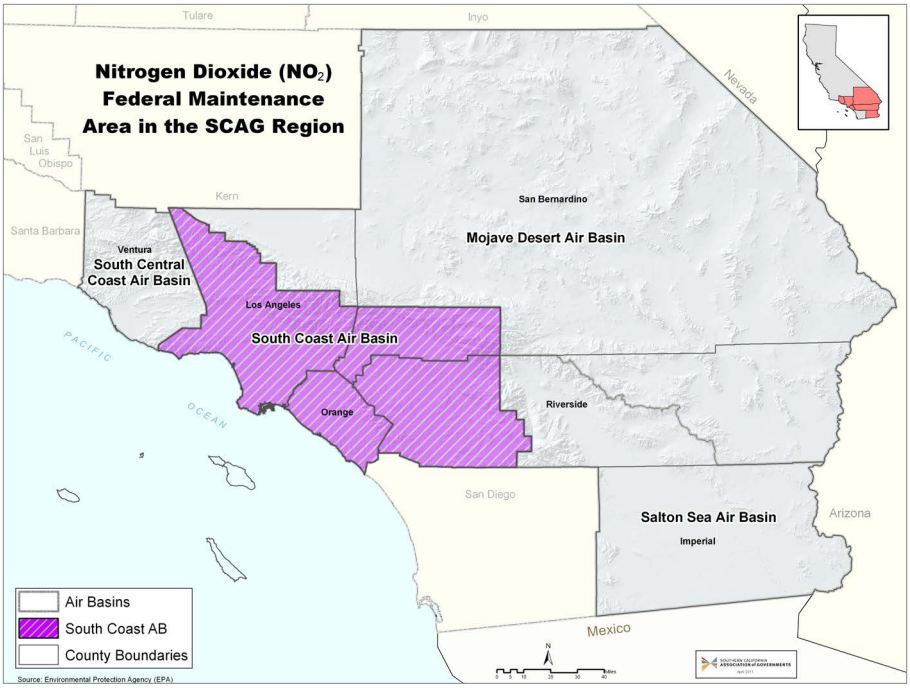
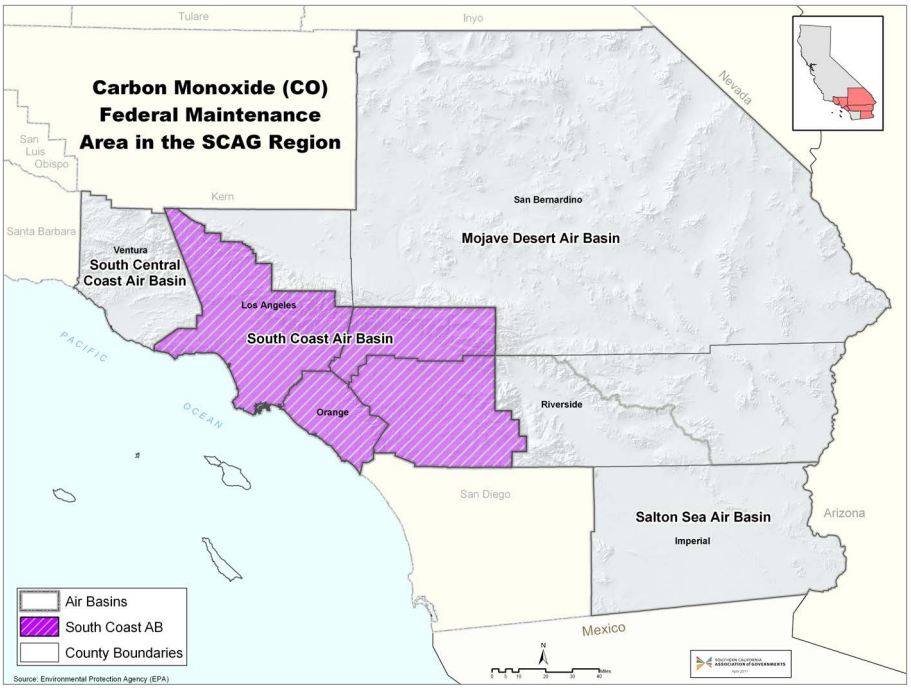
- Air Quality Modeling and Analysis Features
The California Air Resources Board (CARB) developed the California EMission FACtor (EMFAC) model to calculate on-road motor vehicle emissions and transportation conformity process. Effective Nov. 15, 2022, the U.S. Environmental Protection Agency approved EMFAC2021 for use in the state air quality implementation plan (SIP) development and transportation conformity in California. EMFAC2021 is the latest update to the EMFAC model for use by California state and local governments to meet federal Clean Air Act requirements. The new model (EMFAC2021) is based on improved data and new and amended regulations in California. For information about the EMFAC 2021 model, please refer to the California Air Resources Board.
Regional Emission Analysis: The transportation activity data used in the EMFAC model are vehicle miles traveled (VMT) by ranges in speed for light and medium-duty vehicles and heavy-duty trucks. Light and medium-duty vehicles, by CARB’s definition of vehicle class, include passenger cars, light-duty trucks, medium-duty trucks, and motorcycles. The activity data are based on outputs, such as VMT, congested speed, and average travel time.
Transportation Conformity Analysis: Transportation conformity is required by the Clean Air Act section 176© (42 U.S.C 7506(c)) to ensure that federal funding and approval are given to highway and transit projects consistent with (i.e., “conform to”) air quality goals established by a SIP. Conformity to the purpose of the SIP means that transportation activities will not cause new air quality violations, worsen existing violations, or delay timely attainment of the relevant National Ambient Air Quality Standards. Conformity applies to non-attainment and maintenance areas for the following transportation-related criteria pollutants: ozone, PM2.5, PM10, CO, and precursors.
- Air Quality Modeling and Analysis Resources